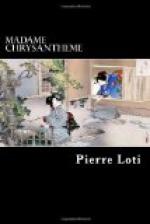* * * * *
On turning a corner of a street, by good luck we meet our married comrades of the Triomphante and Jonquille, Touki-San and Campanule! Bows and curtsies are exchanged by the mousmes, reciprocal manifestations of joy at meeting; then, forming a compact band, we are carried off by the ever-increasing crowd and continue our progress in the direction of the temple.
The streets gradually ascend (the temples are always built on a height); and by degrees as we mount up, there is added to the brilliant fairyland of lanterns and costumes, yet another, ethereally blue in the haze of distance; all Nagasaki, its pagodas, its mountains, its still waters full of the rays of moonlight, seem to rise up with us into the air. Slowly, step by step, one may say it springs up around, enveloping in one great shimmering veil all the foreground, with its dazzling red lights and many-colored streamers.
No doubt we are getting near, for here are the religious steps, porticos and monsters hewn out of enormous blocks of granite. We now have to climb a series of steps, almost earned by the surging crowd ascending with us.
The temple court-yard; we have arrived.
This is the last and most astonishing scene in the evening’s fairy-tale,—a luminous and weird scene with fantastic distances lighted up by the moon and the gigantic trees, the sacred cryptomerias, stretching forth their dark somber boughs like a vast dome.
Here we are all seated with our mousmes, beneath the light awning wreathed in flowers, of one of the many little tea-houses improvised in this courtyard. We are on a terrace at the top of the great steps, up which the crowd continues to flock; we are at the foot of a portico which stands up erect with the rigid massiveness of a colossus against the dark night sky; at the foot also of a monster, who stares down upon us, with his big stony eyes, his cruel grimace and smile.
This portico and the monster are the two great overwhelming masses in the foreground of the incredible scene before us; they stand out with dazzling boldness against the vague and ashy blue of the distant sphere beyond; behind them, Nagasaki is spread out in a bird’s-eye view, faintly outlined in the transparent darkness with myriads of little colored lights, and the extravagantly dented profile of the mountains is delineated on the starlit sky, blue upon blue, transparency upon transparency. A corner of the harbor is also visible, high up, undefined like a lake lost in the clouds; the water faintly illumined by a ray of moonlight shining forth like a sheet of silver.




